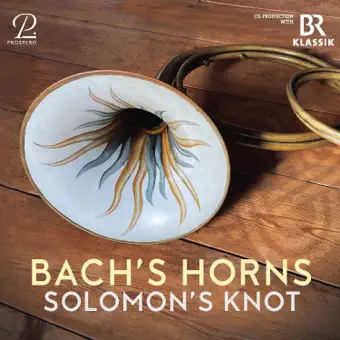september 2025
Bach's Horns (Live)
Solomon’s Knot
Drie werken, thematisch en met veel geestdrift aan elkaar verbonden door het uitmuntende collectief uit de barok- en oude muziek, Solomon’s Knot: een geniaal idee, prachtig uitgevoerd en van harte aanbevolen door David Vickers.

Live opgenomen tijdens concerten tijdens de Ansbacher Bachweek, presenteert Solomon's Knot muziek met hoorns, ontworpen voor hofvermaak in Weimar, Weissenfels en Köthen, of voor liturgische muziek in de kerken van Leipzig. De natuurhoorns van Anneke Scott en Anna Drysdale klinken prachtig met viscerale verstoring, flamboyantie op het koord of koninklijke waardigheid (en soms al die elementen tegelijk). Er is een gelijkwaardige verfijning in de schijnwerpers voor concertante strijkers en houtblazers, en de acht zangers van het collectief schakelen behendig tussen solo's en koorinteracties.
Ze beginnen met de korte Mis in F majeur (Leipzig, eind jaren 1730). Het plechtige Kyrie bevat een luthers koraal, maar dan barst 'Gloria in excelsis Deo' enthousiast los met joelende hoorns, bruisende strijkers en giechelende hobo's; De uitbundige zangers staan onterecht op de voorgrond ten koste van hun instrumentale tegenhanger, maar 'Cum Sancto Spiritu' bereikt een beter gebalanceerde synergie. Jonathan Sells' gearticuleerde 'Domine Deus' gaat zonder pauze over in de serene dialoog van Zoë Brookshaw en hoboïst Daniel Lanthier in 'Qui tollis'. George Cliffords lenige viool converseert geanimeerd met James Hall ('Quoniam').
Er zijn wetenschappelijke vermoedens dat een vroege korte versie van het eerste Brandenburgse Concert een sinfonia zou kunnen zijn geweest voor de jachtcantate Was mir behagt, ist nur die muntre Jagd, hetzij bij de première in 1713 ter gelegenheid van de verjaardag van hertog Christian van Saksen-Weissenfels, hetzij als een van de vele hernemingen voor hertog Ernst August in Weimar. Deze speculatie is de katalysator voor Solomon's Knot, die het hele concert over de cantate verspreidt. De prominente hoornfanfares en bruisende energie van het eerste deel vormen de basis voor Diana's verkondiging dat ze niets liever doet dan jagen (Brookshaws vrolijke 'Jagen ist die Lust der Götter') en haar daaropvolgende geruststelling aan de onzekere Endymion dat ze ook nog steeds van hem houdt (zijn bezorgdheid wordt vurig verwoord door Thomas Herford). Het lyrische, door hobo geleide Adagio van het concerto is ingevoegd om de afdaling van Pan op te roepen – de houtblazers sluiten aan bij diens bucolische 'Ein Fürst ist seines Landes Pan!' (uitbundig gezongen door Alex Ashworth). Pales' charmante pastorale 'Schafe können sicher weiden' combineert de zachtheid, golvende blokfluiten en James Johnstones gevoelige gebruik van de luitstop van het klavecimbel. De menuetten, trio's en polonaises van het concert fungeren als een ballet-divertissement voorafgaand aan het laatste deel van de lofzang. Een instrumentaal ensemble en vier personages sluiten elegant aan in een slotkoor dat overgaat in het urbane derde deel van het concert. De frisse manier waarop deze drie bekende werken aan elkaar zijn geregen, is ingenieus en verrukkelijk.

Recorded live in concerts during the Ansbach Bach Week, Solomon’s Knot present music with horns devised for courtly entertainments in Weimar, Weissenfels and Cöthen, or for liturgical music-making in Leipzig’s churches. Anneke Scott and Anna Drysdale’s natural horns resound splendidly with visceral disruption, high-wire flamboyance or regal dignity (and sometimes all those elements at once). There is equivalent sophistication in spotlights for concertante strings and woodwinds, and the collective’s eight singers switch adeptly between solos and choral interactions.
They begin with the short Mass in F major (Leipzig, late 1730s). The solemn Kyrie incorporates a Lutheran chorale but then ‘Gloria in excelsis Deo’ bursts in excitedly with whooping horns, bustling strings and chuckling oboes; the fulsome singers are unduly at the forefront to the detriment of their instrumental counterpart but ‘Cum Sancto Spiritu’ achieves better-balanced synergy. Jonathan Sells’s articulate ‘Domine Deus’ segues without pause into Zoë Brookshaw and oboist Daniel Lanthier’s serene dialogue in ‘Qui tollis’. George Clifford’s lithesome violin converses animatedly with James Hall (‘Quoniam’).
There is scholarly conjecture that an early short version of the first Brandenburg Concerto could have been a sinfonia for the hunt cantata Was mir behagt, ist nur die muntre Jagd, either at its first outing in 1713 for the birthday of Duke Christian of Saxe-Weissenfels or one of several revivals for Duke Ernst August in Weimar. This speculation is the catalyst for Solomon’s Knot dispersing the entire concerto across the cantata. The first movement’s prevalent horn fanfares and bustling energy set up Diana’s proclamation that she loves nothing better than hunting (Brookshaw’s mirthful ‘Jagen ist die Lust der Götter’) and her subsequent reassurance of the insecure Endymion that she still loves him too (his anxiety is expressed ardently by Thomas Herford). The concerto’s lyrical oboe-led Adagio is inserted to evoke the descent of Pan – its woodwinds connect to the god’s bucolic ‘Ein Fürst ist seines Landes Pan!’ (sung lustily by Alex Ashworth). Pales’s charming pastoral ‘Schafe können sicher weiden’ blends Clare Lloyd-Griffiths’s gentleness, undulating recorders and James Johnstone’s sensitive use of the harpsichord’s lute stop. The concerto’s minuets, trios and polonaise function as a balletic divertissement prior to the panegyrical cantata’s last stretch. An instrumental panoply and four characters dovetail elegantly in a final chorus that forges ahead into the concerto’s urbane third movement. The fresh way that these three familiar works are strung together is ingenious and delightful.
